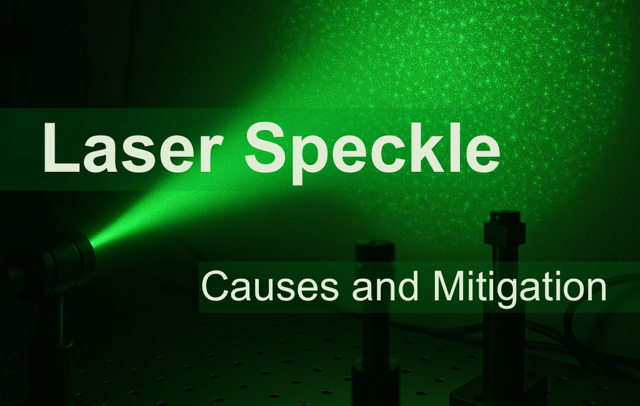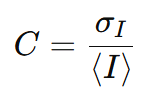Laser speckle, its relation to coherence and its causes, measurement and mitigation is the topic of this blog article.

This article is brought to you by DataRay Inc., a leading manufacturer of laser beam profiling solutions.
Introduction: Understanding Laser Speckle
When coherent light from a laser illuminates a rough surface or passes through a scattering medium, it produces a random interference pattern known as laser speckle. This pattern consists of bright and dark granular spots that arise because of the constructive and destructive interference of the reflected or scattered light waves.
While the phenomenon is visually simple, its implications in optical systems are complex. Speckle can degrade image quality, reduce contrast, and introduce measurement uncertainty in precision metrology systems. On the other hand, it can also be useful – for example, in techniques like speckle interferometry, flow measurement, or tissue imaging, where speckle fluctuations provide valuable information about motion or structure.
The Role of Coherence in Laser Speckle Formation
Laser speckle is fundamentally tied to the coherence properties of the light source, both spatial and temporal coherence play essential roles.
Spatial coherence describes how uniform the phase of a light wave is across its wavefront. Lasers typically exhibit very high spatial coherence, meaning all parts of the beam maintain a fixed phase relationship. This property is crucial for focusing and interference-based applications but also the main reason speckle occurs.
Temporal coherence, on the other hand, refers to how stable the phase of a light wave is over time – essentially determined by the linewidth or spectral width of the source. A narrow-linewidth laser (long coherence length) produces strong, high-contrast speckle, while broader-linewidth sources (like LEDs or superluminescent diodes) generate weaker, washed-out speckle patterns.
Therefore, reducing speckle often involves reducing coherence either spatially and/or temporally, while maintaining sufficient brightness and directionality for the application.
How Speckle Affects Optical and Imaging Systems
Speckle is not merely an aesthetic issue; it can significantly affect performance in imaging, projection, and metrology systems.
In laser projection displays, speckle reduces perceived image quality and brightness uniformity. In machine vision and optical inspection, it can mask small surface defects or distort pattern recognition algorithms. For interferometric and confocal microscopy, speckle introduces unwanted noise that limits contrast and spatial resolution.
In precision metrology, such as laser triangulation, optical profilers, and surface roughness measurement, the presence of speckle can alter intensity readings and lead to measurement inaccuracies. This is particularly critical when sub-micron precision is required.
Quantifying Laser Speckle: Contrast and Correlation
Speckle is typically quantified using the speckle contrast (C), defined as the ratio of the standard deviation of intensity to the mean intensity in the observed pattern:For fully developed speckle, C≈1, while for partially coherent or averaged speckle, C<1.
Measuring speckle can be done with the help of laser beam profilers and the measured contrast can help characterize the coherence of a laser or assess the effectiveness of speckle reduction techniques. Another useful metric is the autocorrelation function of the speckle pattern, which reveals information about the scattering surface or the imaging system’s resolution.
Modern cameras and image sensors, combined with digital signal processing, make it straightforward to compute these parameters in real time, aiding in both research and quality control.
Common Speckle Reduction Techniques
Since laser speckle originates from high coherence, most mitigation techniques aim to reduce coherence or average multiple independent speckle patterns within the detector’s integration time. Several practical methods exist depending on the application’s requirements for brightness, speed, and precision.
1. Temporal Averaging
If the relative phase or path length of the interfering waves changes rapidly over time, the resulting speckle pattern fluctuates. By integrating over many fluctuating speckle realizations (using a longer camera exposure time or higher modulation frequency), the perceived speckle contrast decreases. Temporal averaging can be achieved by:
Modulating the laser wavelength (wavelength dithering)
Vibrating or rotating diffusers in the optical path
Using multiple lasers with slightly different wavelengths

Example of a laser speckle measurement with and without homogenizer in the beam path (courtesy of OZ Optics)
2. Spatial Averaging
Using optical diffusers, multimode fibers, or integrating spheres can reduce spatial coherence by mixing multiple phase fronts. Spatial averaging works well for projection systems and display applications, where absolute coherence is not essential but uniform illumination is.
3. Polarization Diversity
Since two orthogonal polarizations produce uncorrelated speckle patterns, combining them effectively halves the speckle contrast. Many display systems employ depolarizers or polarization scramblers to achieve this effect.
4. Source Engineering
Replacing the laser source with a superluminescent diode (SLD) or a broadband laser can naturally reduce speckle without external components. These sources maintain good brightness while offering lower temporal coherence, striking a balance between image quality and illumination efficiency.
Applications Where Speckle Matters Most
Speckle plays a dual role in modern optics – a nuisance in some applications and a useful signal in others.
In laser projection and display technology, speckle reduction is a major design challenge, especially as high-brightness RGB laser projectors become more common. In optical metrology, however, controlled speckle is used to measure micro-displacements or vibrations via digital speckle pattern interferometry (DSPI) and speckle photometry.
In biomedical imaging, techniques like laser speckle contrast imaging (LSCI) exploit speckle dynamics to map blood flow and tissue perfusion. The speckle fluctuations caused by moving red blood cells provide a non-contact, real-time measure of tissue activity – a perfect example of turning an optical artifact into a diagnostic tool.
Future Directions in Speckle Control
Advancements in MEMS-based dynamic diffusers, spatial light modulators (SLMs), and digital micromirror devices (DMDs) are driving new approaches to real-time speckle suppression. Some emerging solutions use AI-driven control algorithms to adaptively alter the phase or amplitude of the beam, minimizing speckle without significantly reducing brightness or resolution.
At the same time, novel laser architectures such as multi-emitter diode arrays and frequency-comb lasers provide a natural path toward high brightness with reduced coherence, enabling speckle-free illumination even in compact or mobile optical systems.
Conclusion
Laser speckle is an unavoidable consequence of the coherence that makes lasers so useful. While it can degrade image quality and measurement precision in many optical systems, modern optical engineering provides multiple ways to control, reduce, or even harness it.
By understanding the relationship between coherence and speckle, engineers can choose the right combination of source design, modulation, and optical components to balance coherence where it’s needed — and suppress it where it’s not. As lasers continue to evolve toward higher brightness and wider application diversity, mastering speckle control will remain central to advancing imaging, metrology, and display performance.
Further Reading and References
Goodman, J. W. Speckle Phenomena in Optics: Theory and Applications, 2nd Edition. Roberts and Company, 2007.
— The definitive reference on laser speckle theory, coherence, and statistical analysis.Dainty, J. C. (Ed.). Laser Speckle and Related Phenomena. Springer-Verlag, 1984.
— Classic text covering fundamental physics and early experimental studies of speckle.Briers, J. D. “Laser Speckle Contrast Imaging for Measuring Blood Flow.” Optica Applicata, Vol. 37, No. 1-2 (2007): 139–152.
— Overview of biomedical imaging techniques based on speckle contrast dynamics.Fercher, A. F., and Briers, J. D. “Flow Visualization by Means of Single-Exposure Speckle Photography.” Optics Communications, Vol. 37, Issue 5 (1981): 326–330.
— Foundational paper describing laser speckle flowmetry.Osten, W., and Gao, P. “Speckle in Optical Metrology: From Noise to Information.” Light: Science & Applications, Vol. 3, No. 12 (2014): e157.
— Modern perspective on using speckle as a metrology tool.Redding, B., Choma, M. A., and Cao, H. “Speckle-Free Laser Imaging Using Random Lasers.” Nature Photonics, Vol. 6, No. 6 (2012): 355–359.
— Demonstrates speckle suppression using novel incoherent laser sources.Wang, Z., and Yamaguchi, I. “Digital Holographic Microscopy for Quantitative Phase Imaging.” Optics Letters, Vol. 19, No. 3 (2007): 206–212.
— Relevant for readers interested in interferometric imaging and speckle-related phase noise.Briers, J. D., Duncan, D. D., Hirst, E. R., Kirkpatrick, S. J., Larsson, M., Steenbergen, W., and Stromberg, T. “Laser Speckle Contrast Imaging: Theoretical and Practical Limits.” Journal of Biomedical Optics, Vol. 18, No. 6 (2013): 066018.
— A comprehensive review of speckle contrast imaging theory and instrumentation.Wang, L., and Wu, J. Biomedical Optics: Principles and Imaging. Wiley-Interscience, 2007.
— Includes sections on laser coherence, speckle, and light scattering in tissues.Smith, A. M., Mancini, M. C., and Nie, S. “Bioimaging: Second Window for In Vivo Imaging.” Nature Nanotechnology, Vol. 4 (2009): 710–711.
— Discusses speckle and coherence considerations in biomedical laser imaging.

